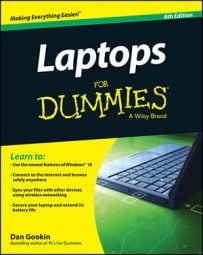You must charge your laptop battery to keep it operational. You charge your laptop battery by plugging the laptop into a wall socket. You can recharge your battery whether the battery is fully drained or not.
Note that lithium-ion batteries have a rapid-charging option. This option is available either on a custom tab inside the Power Options dialog box or through special battery software that came with your laptop. In a pinch, a rapid charge can save time. Otherwise, you want a nice, full, slow charge for your laptop’s battery. Other battery-charging points are as follows:
-
You can recharge your laptop’s battery whether the battery is fully drained or not. Especially if your laptop is using a lithium-ion battery, it makes no difference.
-
Lithium-ion batteries have a rapid-charging option. This option is available either on a custom tab inside the Power Options dialog box or from special battery software that came with your laptop. In a pinch, a rapid charge can save time. Otherwise, you want a nice, full, slow charge for your laptop's battery.
-
Leave your laptop plugged into the wall socket whenever possible.
-
There’s no need to fully drain your laptop's lithium-ion battery every time you use it.
-
The battery continues to charge even when the laptop is turned off.
-
It doesn’t take longer to recharge the battery if you use the laptop while recharging.
-
Never short a battery to fully drain it. By short, I mean that you connect the two terminals (positive and negative) directly so that the battery simply drains. This is a very bad, stupid thing to do. It can cause a fire. Don't do it.

